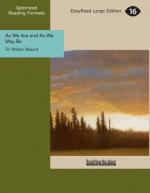That was one side—perhaps the most important side. But the halo of adventure still lay glowing in the western land. No colony but had its history of massacre, treachery, and war to the knife with the Red Indian. Long before the time of Fenimore Cooper the English lad could read stories of dreadful tortures, of heroic daring, of patience and endurance, of revenges fierce, of daily and hourly peril. The blood of the Dragon ran yet in English veins. America was still to the heirs and successors of that Great Heart the Land of Romance and the Land of Gallant Fights.
And such stories! That of Captain John Smith laying his head upon the block that it might be smashed by the Indians’ clubs, and of his rescue by the Indian girl, afterwards the ‘Princess Rebecca’; the massacre of three hundred and fifty men, women and children of the infant colony of Virginia, a hundred stories of massacre. Or, that story of the mother’s revenge, told, I believe, by Thoreau. Her name was Hannah Dunstan. Her house was attacked by Indians; her husband and her elder children fled for their lives; she, with an infant of a fortnight, and her nurse, were left behind. The Indians dashed out the brains of the baby and forced the two women to march with them through the forest to their camp. Here they found an English boy, also a prisoner. Hannah Dunstan made the boy find out from one of the Indians the quickest way to strike with the tomahawk so as to kill and to secure the scalp. The Indian told the boy. Now there were in the camp two men, three women, and seven children. In the dead of night Hannah got up, awakened her nurse and the boy, secured the tomahawks, and in the way the unsuspecting Indian had taught the boy, she tomahawked every one—man, woman and child—except a boy who fled into the woods—and took their scalps. Then she scuttled all the canoes but one, and taking the scalps with her as proof of her revenge, she put the nurse and the boy into the canoe and paddled down the river. She escaped all roving bands and won her way home again to find her husband and sons safe and well, and to show the scalps—the blood payment for her murdered child. Such were the stories told and retold in every colonial township, round every fire; such were the stories brought home by the sailors and the merchants; they were published in books of travel. Think you that our English blood had grown so sluggish that it could not be fired by such tales? Think you that the romance of the Colonies was one whit less enthralling than the romance of the Spanish Main?




